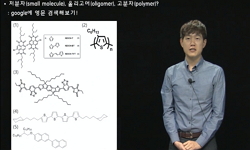The field of bioelectronics, originating in the late 18th century with Luigi Galvani’s seminal experiments on electrical stimulation in animal tissues, has since grown into a transformative area of research and development. Fundamentally, bioelectro...
http://chineseinput.net/에서 pinyin(병음)방식으로 중국어를 변환할 수 있습니다.
변환된 중국어를 복사하여 사용하시면 됩니다.
- 中文 을 입력하시려면 zhongwen을 입력하시고 space를누르시면됩니다.
- 北京 을 입력하시려면 beijing을 입력하시고 space를 누르시면 됩니다.
Electrochemically Active Melanin-like Polydopamine and Their Composites for Bioelectronic Applications = 생체전자 응용을 위한 전기화학적 활성의 유사멜라닌 폴리도파민 및 이의 복합재
한글로보기https://www.riss.kr/link?id=T17197717
- 저자
-
발행사항
인천 : 인하대학교 대학원, 2025
-
학위논문사항
학위논문(박사) -- 인하대학교 대학원 , 사이언스·엔지니어링전공 스마트공학 , 2025. 2
-
발행연도
2025
-
작성언어
영어
- 주제어
-
발행국(도시)
인천
-
형태사항
107 ; 26 cm
-
일반주기명
지도교수: 심봉섭
-
UCI식별코드
I804:23009-200000858646
- 소장기관
-
0
상세조회 -
0
다운로드
부가정보
다국어 초록 (Multilingual Abstract)
The field of bioelectronics, originating in the late 18th century with Luigi Galvani’s seminal experiments on electrical stimulation in animal tissues, has since grown into a transformative area of research and development. Fundamentally, bioelectronics aims to bridge the gap between biology and electronics, enabling interventions in cases of disorders or pathologies. For example, neural implants interpret brain signals, allowing individuals to control prosthetic limbs through thought alone, while portable glucose monitors enable diabetic patients to regulate their blood sugar levels more effectively. These applications highlight bioelectronics' positive impact on quality of life and its central role in advancing healthcare. This growing demand for bioelectronics in modern society makes it difficult to control the emergence of electronic waste, as majority of devices are based on metals and inorganic materials. To align with both "sustainability" and “seamless integration” with biological systems, future generations of electronics must prioritize designs that are low-cost, biodegradable, and recyclable, adhering to the principles of a circular economy. Simultaneously, these devices should be mechanically flexible, biocompatible, and both electronically and ionically conductive, ensuring a functional interface between biology and electronics. In this context, organic electronic materials, particularly conducting polymers, have emerged as promising alternatives due to their unique properties. However, the balance between biocompatibility and electrochemical performance remains a significant challenge for the broader application of conducting polymers. An alternative approach to address these limitations could involve partially or entirely substituting widely used synthetic conducting polymers like polyaniline, polypyrrole, and poly-3,4-ethylenedioxythiophene with naturally derived conjugated polymers, such as melanin, or their composites. Melanin, derived from the Greek word “melanos” meaning “dark,” was comprehensively defined as a pigment with diverse structures formed through the oxidation and polymerization of tyrosine in animals or phenolic compounds in other organisms. Melanin’s broad UV-visible absorption, metal-ion chelation, redox properties, hybrid ionic-electronic conductivity, biocompatibility and biodegradability suggest its suitability for bioelectronic applications. Melanin can be extracted from natural sources such as squid ink and black soldier fly, however, the final structure of melanin that is synthesized in vivo contains tightly bound biological components and metal cations within melanin. Any attempt to remove these proteins and other molecules may result in damaging the structural features and functionalities of melanin. Therefore, melanin-like polymers can be synthesized with enhanced structural control, circumventing the challenges posed by natural extraction methods. The most common procedure to obtain synthetic melanin is the auto-oxidation of dopamine (DA) precursors in aqueous buffers, resulting in the formation of polydopamine (PDA), also called as melanin- like polymer. The structure of melanin-like polymers, including their monomer composition, conjugation, and chain length, can vary depending on the preparation method, which consequently alters their properties. However, most studies focus on melanin’s roles as an adhesive, antioxidant, and biocompatible material rather than as a conductive component. This is predominantly due to the inherent insulating characteristics stemming from the conventional chemical synthesis of melanin. Only a few studies to date have achieved conductive melanin synthesis. This thesis explores the potential of melanin-like polymers for bioelectronics, highlighting their promising properties and potential advantages over conventional conducting polymers. To function effectively as active components in electronic devices, melanin-like polymers must possess conductive characteristics. Achieving this requires synthesizing a conjugated backbone structure under precisely controlled oxidative conditions. Therefore, we investigated the electrochemical synthesis of melanin-like polymers to ensure greater control over the final structure. Chapter 1 of this thesis provides an overview of bioelectronic design principles, focusing on natural and synthetic melanin-like polymers and their structure-property-function relationships. As the thesis aims to enhance the electrochemical properties of melanin-like polymers, background information on charge transport in organic materials and the electrical property of melanin is also provided. Chapter 2 discusses the electrochemical synthesis of highly conductive melanin-like polymers achieved through dopant engineering. To the best of our knowledge, this is the first study to systematically investigate the role of various counterions that can be incorporated into PDA during its electrochemical synthesis. Several counterions, including lithium perchlorate (LiClO4), hexafluorophosphate (KPF6), sodium p-toluene sulfonate (Na+-pTS), iron p-toluene sulfonate (Fe3+-pTS), and poly(sodium 4-styrenesulfonate) (PSS), were tested to determine their potential for electrochemically doping PDA to achieve conductivity. In Chapter 3, we further explore the incorporation of negatively charged, chemically synthesized poly(L-DOPA) nanoparticles as counterions during the electrochemical polymerization of PDA, creating melanin-like composites. After achieving high conductivity, we demonstrated the electrocatalytic activity of the resulting composite toward glucose oxidation. This material showed excellent performance in non-enzymatic glucose sensing, effectively addressing the stability issues common in enzyme-based glucose sensors, as well as the low selectivity and potential toxicity of metal nanoparticle-based non- enzymatic sensors. Chapter 4 investigates the integration of carbon-based materials, specifically liquid crystalline graphene oxide (LCGO), with PDA. The resulting PDA:LCGO composite exhibited enhanced electrochemical performance due to the synergistic effect of PDA’s conductivity and LCGO’s high surface area. Chapter 5 serves as a concluding chapter wherein we summarize the findings outlined in this thesis and propose future investigations that our work has made feasible. Overall, the multifunctional properties of melanin-like polymers, coupled with their biodegradability, offer a promising pathway for advancements in future bioelectronics, supporting new directions for developing medical diagnostics and therapy, with an environmentally responsible approach.
목차 (Table of Contents)
- CHAPTER 1. Material Properties and Functional Insights into Melanin and Melanin-like Polymers Towards the Design of Bioelectronics 1
- 1-1. General Considerations for Designing Bioelectronics 1
- 1-2. Natural Melanin Family and Melanin-like Polymers 2
- 1-3. Structure-Property-Function Relationship of Melanin and Melanin-like Polymers 6
- 1-4. Charge Transport Mechanisms 11
- CHAPTER 1. Material Properties and Functional Insights into Melanin and Melanin-like Polymers Towards the Design of Bioelectronics 1
- 1-1. General Considerations for Designing Bioelectronics 1
- 1-2. Natural Melanin Family and Melanin-like Polymers 2
- 1-3. Structure-Property-Function Relationship of Melanin and Melanin-like Polymers 6
- 1-4. Charge Transport Mechanisms 11
- 1-5. Electrical Properties of Melanin and Melanin-like Polymers 14
- CHAPTER 2. Versatile Conductive Polydopamine via Tailoring Counterions 17
- 2-1. Introduction 17
- 2-2. Experimental Section 19
- 2-2-1. Materials and Instruments 19
- 2-2-2. Electrochemical Polymerization of PDA with Various Counterions 19
- 2-2-3. Electrochemical Performance Analysis 20
- 2-3. Results and Discussion 21
- 2-3-1. Electrochemical Synthesis of Conductive PDA with Different Counterions 21
- 2-3-2. Electrochemical Performance of Conductive PDA 25
- 2-3-2-1. Electrochemical Durability of the PDA-coated Electrodes 29
- 2-3-3. Morphological and Chemical Characterization of Conductive PDA 30
- 2-4. Conclusion 36
- 2-5. Supporting Information 38
- CHAPTER 3. Highly Conductive Melanin-like Polymer Composites for Non-Enzymatic Glucose Biosensors with Wide Detection Range 51
- 3-1. Introduction 51
- 3-2. Experimental Section 53
- 3-2-1. Materials 53
- 3-2-2. Chemical Synthesis of PLDA NPs 53
- 3-2-3. Electropolymerization and Characterization of eMLP 53
- 3-3. Results and Discussion 55
- 3-3-1. Electrochemical Polymerization and Co-deposition of Conductive Melanin-Like Polymers 55
- 3-3-2. Application of Conductive Melanin-Like Polymers as Non-Enzymatic Glucose Sensors 61
- 3-4. Conclusion 66
- 3-5. Supporting Information 67
- CHAPTER 4. Synergistic Polydopamine/Graphene Oxide Hybrids: Elevating Electrochemical Performance 71
- 4-1. Introduction 71
- 4-2. Experimental Section 72
- 4-2-1. Materials and Instruments 72
- 4-2-2. Preparation of Liquid Crystalline Graphene Oxide 72
- 4-2-3. Electrochemical Deposition of PDA and PDA:LCGO 72
- 4-2-4. Electrochemical Performance of PDA and PDA:LCGO Electrodes 72
- 4-3. Results and Discussion 74
- 4-3-1. Electrochemical Synthesis of PDA and PDA:LCGO 74
- 4-3-2. Effect of Increased DA:GO Ratio 81
- 4-3-3. Stability of PDA and PDA:LCGO Electrodes in Different pH 84
- 4-3-4. Electrochemical Durability of PDA and PDA:LCGO Electrodes 87
- 4-4. Conclusion 88
- 4-5. Supporting Information 89
- CHAPTER 5. Conclusion and Future Perspectives 95
- REFERENCES 99










